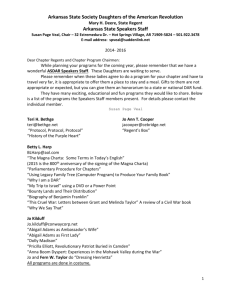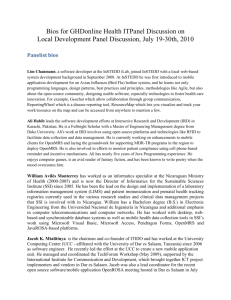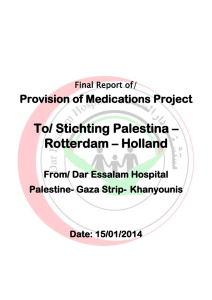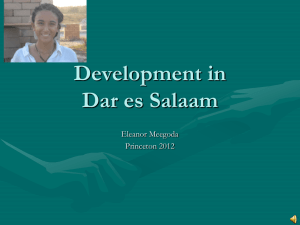FINAL_Book_DAR-2014
advertisement
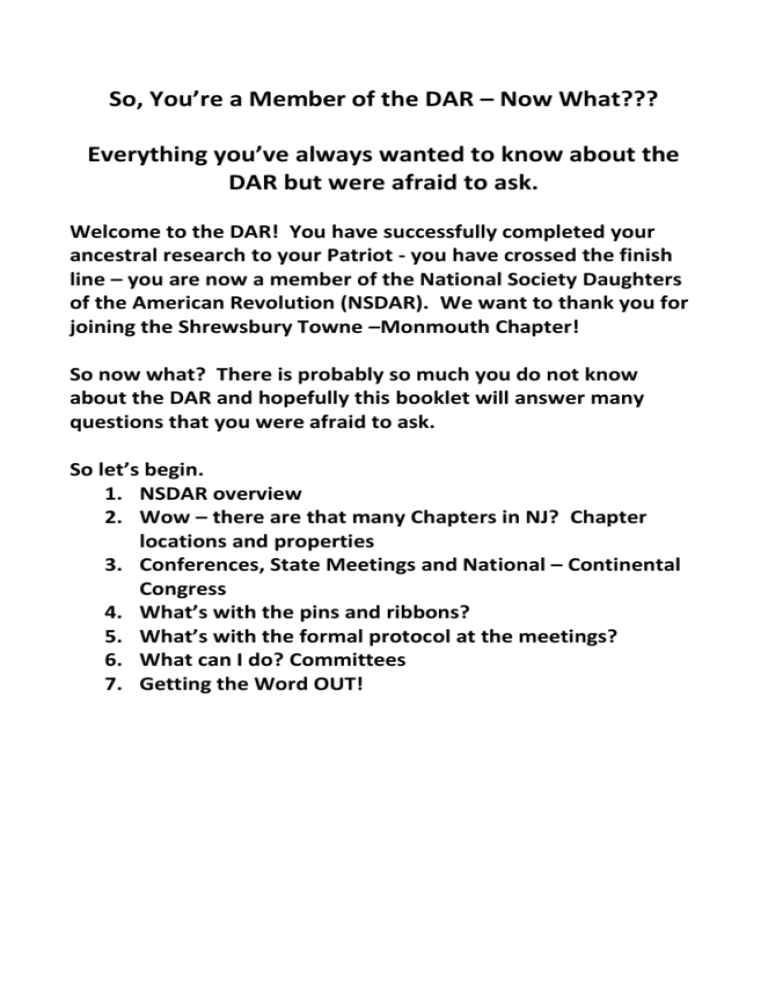
So, You’re a Member of the DAR – Now What??? Everything you’ve always wanted to know about the DAR but were afraid to ask. Welcome to the DAR! You have successfully completed your ancestral research to your Patriot - you have crossed the finish line – you are now a member of the National Society Daughters of the American Revolution (NSDAR). We want to thank you for joining the Shrewsbury Towne –Monmouth Chapter! So now what? There is probably so much you do not know about the DAR and hopefully this booklet will answer many questions that you were afraid to ask. So let’s begin. 1. NSDAR overview 2. Wow – there are that many Chapters in NJ? Chapter locations and properties 3. Conferences, State Meetings and National – Continental Congress 4. What’s with the pins and ribbons? 5. What’s with the formal protocol at the meetings? 6. What can I do? Committees 7. Getting the Word OUT! NSDAR Overview When the Sons of American Revolution (SAR) voted in 1890 to exclude women from their patriotic society, four working women in the District of Columbia – Mary Lockwood, Mary Desha, Eugenia Washington, and Elle Hardin Walworth – formed their own patriotic society. In the words of former DAR President General Patricia Walton Shelby: “Our founders were the first to proclaim women’s rights and do something about it.” The Daughters of the American Revolution (DAR) was founded in 1890, and is headquartered in Washington, DC. DAR is a non-profit, non-political volunteer women's service organization dedicated to promoting patriotism, preserving American history, and securing America's future through better education for children. DAR members volunteer more than 250,000 hours annually to military veteran patients, award many thousands of dollars in scholarships and financial aid each year to students, and support schools for the underprivileged with annual donations exceeding one million dollars. The DAR National Headquarters encompasses an entire downtown city block in Washington D.C. and houses one of the nation's premier genealogical libraries, one of the foremost collections of pre-industrial American decorative arts, Washington's largest concert hall, and an extensive collection of early American manuscripts and imprints DAR Facts Founded: October 11, 1890 Incorporated 1896 by an Act of Congress Objectives: Historic Preservation, Education, Patriotism Motto: God, Home, and Country Membership: 177,000 members 3,000 chapters in all 50 states and Washington, D.C.; International chapters in Australia, Austria, Bahamas, Bermuda, Canada, France, Germany, Guam, Italy, Japan, Mexico, Russia, Spain, United Kingdom More than 930,000 women have joined the DAR since it was founded NSDAR Management President General: Lynn F. Young The National Society is led by the President General and an Executive Committee of 11 National Officers who serve a three year term. In addition to rulings by the Executive Committee, policy for the Society is made by the National Board of Management, a body composed of the Executive Officers, 21 Vice Presidents General, and 53 State Regents. The National Board of Management meets six times a year at DAR headquarters in Washington, D.C. Most of DAR's volunteer work is accomplished under a committee system comprised of national chairs appointed by the President General and locally appointed state and chapter chairs. The national chairs direct and supervise the activities of their committees with the assistance of the national vice chairs. NJDAR (New Jersey Daughters of the American Revolution) State Regent: Cornelia B. Olde The New Jersey State Society (NJDAR) was organized on April 29, 1891. Today, there are forty-six chapters located throughout the state. We are honored that you chose to be a member of the Shrewsbury Towne – Monmouth Chapter. The Shrewsbury Towne-Monmouth Chapter was created by the 2004 merger of two chapters — Shrewsbury Towne and Monmouth. The Monmouth Chapter was created in 1900, and named for the Battle of Monmouth; the Shrewsbury Towne Chapter was established in 1935, and was named for the town of Shrewsbury, where the chapter was organized. So who are the officers that oversee each Chapter? Each Chapter consists of the following positions: Regent 1st Vice Regent Chaplain Recording Corresponding Secretary Treasurer Registrar Historian Librarian New Jersey Chapter Homes and Properties Our chapters and their members are varied and diverse. The state’s 46 chapters are divided up within three districts: Northern, Central (of which Shrewsbury Towne-Monmouth Chapter is a member) and Southern. Members of these chapters donate their time to local Veteran facilities, are docents at historical homes and/or make monetary donations to historical preservation or local community outreach. And some of these chapters have properties that require constant vigilance and financial support. These properties are: The Elias Van BunSchooten House (1787) in Wantage is maintained by the Chinkchewunska Chapter. The Schuyler-Hamilton House (1755) in Morristown is designated as a Historical Landmark and is property of the Morristown Chapter. The Revolutionary Cemetery, located in the center of Springfield, is maintained by the Church and Cannon Chapter. Fleming Castle (1756) in Flemington is owned by the Colonel Lowrey Chapter. From 1933 – 1947 the General Frelinghuysen Chapter owned the Old Dutch Parsonage (1751). A gift from Senator Joseph Frelinghuysen, it was preserved and deeded to the State of New Jersey Department of Conservation and Development. The chapter still holds its meetings in the Old Dutch Parsonage. The Buccleuch Mansion (circa 1734) in New Brunswick is under the custodianship of the Jersey Blue Chapter. Memorial Park in Whitehouse Station is owned by the Old Whitehouse Chapter. Our State Headquarters are in The Isaac Watson House (1708) in Trenton. Outside of New Jersey, the New Jersey Daughters sponsor and maintain The New Jersey Room in the DAR Memorial Continental Hall in Washington D.C. The New Jersey Cottage at the Tamassee DAR School in South Carolina. Conferences, State Meetings and Continental Congress. State Meetings and Conferences New Jersey DAR has two State gatherings a year – a meeting in the Fall and a Spring Conference. Both are currently held at the Westin Princeton in Forrestal Village. Daughters from all over New Jersey come together to attend business sessions, committee meetings, and social functions. The spring conference consists of two days one of which is Awards Day. Awards Day is a day when we acknowledge and award the youth of New Jersey. Winners and their families are invited for lunch and are presented awards in the following areas: The American History Essay Contest, The Christopher Columbus Essay Contest, The Fashion Design Contests, the Good Citizens Award and the Junior American Citizens award. Continental Congress Continental Congress is the time honored national meeting of the DAR membership held annually since the organization’s founding in 1890. It is held in Washington DC and it is a wonderful conference that each Daughter should try to experience at least once. National, State and Chapter DAR leaders as well as other members from across the world meet at the DAR National Headquarters for a week during the summer to report on the year’s work, honor outstanding award recipients, plan future initiatives and reconnect with friends. The week-long convention consists of business sessions, committee meetings, social functions, and is topped off with four formal evening ceremonies. These evening ceremonies, held in the historic DAR Constitution Hall, mix pomp and circumstance with touching award presentations and musical entertainment. In addition to member awards and student essay and scholarship awards, the DAR presents its top national awards at the convention. Meeting Protocol Before you go to a meeting – you should know that the meeting will follow Robert’s Rules of Order (1915) which is the oldest and most commonly used guide to parliamentary procedure. Protocol may be defined as the ceremonial forms and courtesies which are established as proper and correct or as the proper etiquette for recognizing and honoring those in a position of leadership. The protocol for receiving lines, processions, and seating at DAR functions through the years has been directed by the Protocol Division of the Unites States Department of State. There is only one presiding officer – address that person only. When addressing a Presiding Officer in a Chapter meeting say “Madam Regent.” If the Regent calls upon you for a report, say: “Thank you, Madam Regent” and continue with your report. If you are called upon at a State conference, say: “Thank you, Madam State Regent.” A presiding officer does not applaud and never relinquishes the chair unless a motion or action refers to her only. State conferences begin with a procession of Pages carrying flags, District Directors, State officers, Honorary State Regents Visiting State Regents, Visiting National officers, and the State Regent. If the President General is in attendance, she processes just before the State Regent. The State Regent is the highest ranking officer even if the President General is present. If gloves are worn, and this is usually only in the evening, the glove is removed from the right hand when reciting the Pledge of Allegiance to the Flag of the Unites States of America and when singing the National Anthem. It is customary for gloves to be worn during a receiving line, but it is not mandatory and the hostess sets the example. During the State Conference, the center aisle is used only for the procession and recession. Those giving reports use the side aisles only. And, if possible, never walk in front of the dais. Personal pages are assigned to the State Regent, State Officers, Honorary State Regents, and the General Chairman of the Conferences. There are also pages around the room to help members with any need they may have. To be eligible to be a page – you must be between the ages of 18-36 years and a member of the DAR. So What’s with the Pins and Ribbons? One of the first things you may notice upon entering a DAR meeting are the ribbons and pins worn by DAR members. It may remind you of your days back in the Girls Scouts of America and it is the same premise. Some pins you can outright purchase since you are a now a member of the NSDAR: other pins must be earned. Pins are earned based on committees and positions that you have served. Guidelines for Wearing the DAR Insignia The insignia pin should be worn over the left breast and only by active members. The insignia and pins are worn with a 1-inch wide ribbon which is the same as the ribbon used to create the State Regent's sash. The ribbon is to be attached at the shoulder seam. By ruling of the National Board of Management, a flag pin may be worn on the left lapel when wearing the DAR Insignia. No other jewelry is to be worn on the left side when wearing the insignia pin. The insignia pin may be worn with attire appropriate for DAR occasions, which may include pants and jackets. It should be worn only at functions of the National Society, state organizations, or chapters, or when representing the organization. It may be worn during the dedication of a grave marker for a deceased Daughter and also at the funeral of a Daughter. Daughters may sign the memorial book as DAR members. The DAR insignia should not be worn on the street, in a restaurant, cocktail lounge, or other public places unless a DAR or allied function is taking place. DAR FAQs about Pins Q. I'm a new member. Where do I begin? A. Most new members start with the basic insignia, which consists of the official insignia, chapter bar and ancestor bar. The three pins will automatically be mounted on ribbon for you. You may also start with just the official insignia by purchasing a hidden ribbon top bar. Q. How do I order pins? A. Send an order form with a check or credit card number directly to Hamilton Jewelers or Office of the Organizing Secretary General, NSDAR, 1776 D Street, NW, Washington, DC2 0006-5303.The Office of the Organizing Secretary General will verify the DAR service and immediately forward the order to Hamilton. Q. What state pins can I order? A. You can order the state of your original ancestor service, all supplemental ancestor service states and your membership state. Q. What pins come with ribbon? A. When you place your order for the official emblem, chapter bar and ancestor bar, they will automatically mount on ribbon for you. Any additional ribbon can be ordered in 8, 10, 12 and 14 inch lengths. Q. What pins come in 14k gold? A. Most pins are available by special order in 14k gold and some may be customized with gemstones. Please contact Hamilton Jewelers at 1-800-786-5890 to review your options. So, What Does One Wear To a DAR Meeting? Always remember that how you dress reflects what you think of yourself and of the National Society, which is represented by the DAR Insignia and pins you have on your DAR ribbon. Laura M. Reid, National Chair No, you don’t have to go out and buy a new outfit to attend a DAR meeting, I am sure you have something appropriate in your closet; but if you want a reason to go shopping then go for it! There are however, some common sense guidelines to follow especially when representing the National Society in a community project or program. It all comes down to remembering that how we dress and how we act reflects on the dignity of the Society we represent. The DAR Handbook states: “The insignia may be worn with appropriate dress for DAR occasions, which include pants and jackets.” Pants and jackets indicate a pantsuit or dress pants (not denim) with a nice blouse and/or coordinated jacket. Dresses and skirts and blouses and/or jackets are appropriate. Those who are entitled to wear a sash indicating an active, honorary or past office do not wear the sash when wearing pants of any kind, including evening pants ensembles. What Can I Do? Want to get involved?? There are lots of areas to which we are sure your talents can be applied. The DAR works primarily through a committee system, offering opportunities for leadership, social networking, skill development and participation in projects, locally and globally. DAR committees are the engines that make the society hum. The committees are the way the society promotes its motto of Historic Preservation, Education and Patriotism. Members learn leadership and other skills, make new friends and provide valuable services at home and abroad. Committees are comprised of national chairmen appointed by the National President General, state chairmen appointed by the State Regent and chapter chairmen who implement the current priorities and projects. The best way to become involved and meet other members is to join one or more committees. You do not have to chair one! However, if you do wish to be a chairperson, we offer lots of guidance and support. Below are some of our most active DAR committees: NATIONAL COMMITTEES (*before name indicates lack of chapter chair at this time) American Heritage Committee promotes art and sculpture, crafts, drama and literature, fine arts, and music American History Committee promotes American history through American History Essay Contest American Indians Committee improves educational opportunities for Indians Americanism Committee/ DAR Manual for Citizenship aids those seeking to become naturalized citizens Chapter Achievement Awards Committee measures chapter’s achievement of its goals Children of the American Revolution Committee assists Children of the American Revolution chapter Community Service Awards Committee recognizes individuals for outstanding unpaid voluntary achievements Conservation Committee works to conserve and celebrate our natural heritage and resources Constitution Week Committee commemorates the Constitution (September 17 – 23 each year) DAR Good Citizens Committee encourages and rewards the qualities of good citizenship in high school seniors DAR Magazine Committee celebrates our heritage and keeps up with the latest DAR news DAR Museum Outreach Committee supports Memorial Continental Hall *DAR Scholarship Committee awards college scholarships DAR School Committee promotes education and supports DAR schools DAR Service for Veterans Committee awards outstanding volunteer service Flag of the United States of America Committee promotes patriotism and respect for our flag Genealogical Records Committee adds to unpublished genealogical source materials in the DAR Library Historic Preservation Committee promotes historic preservation, education, and patriotism. * Junior American Citizens Committee promotes principles of democracy and an appreciation of our country Junior Membership Committee supports DAR objectives Lineage Research Committee assists with documentation for application for membership in NSDAR Membership Committee introduces and explains DAR to the prospective member National Defense Committee enlightens public opinion & advocates a strong American military defense Public Relations & Media Committee informs about the mission and activities of the DAR Volunteer Information Specialists Committee uses computer and technology skills to assist DAR Getting the Word Out The best way for people to learn about the Shrewsbury TowneMonmouth Chapter of the DAR is by getting the word out. Community knowledge of the chapter’s activities is of major importance. To accomplish this, the Executive Board sends out press releases to 31 local newspapers, magazines, web sites, and various radio stations. We want the public to know about our chapter and the activities in which we are involved. The more people know about us – the more we will grow and thrive. If you know of a publication that we can place on our mailing list, please let us know so that we can contact them. Every year the press is invited to attend some of our special meetings. Reporters have been seen at our December holiday banquet and at our Awards meeting in April, where we honor the winners of the American History Essay contest. We also need your help. Please bring us any published articles that you might see about our chapter. These articles are placed in our archives to document our chapter’s activities. On the National level, every year we share a chapter photo and a 200 word story about our chapter in the Daughters of the American Revolution Newsletter which is mailed to members, along with the DAR American Spirit magazine. If you can think of any other way to get the word out – let us know – we are open to suggestions!

